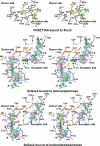Molecular mechanisms of yeast cell wall glucan remodeling
- PMID: 19097997
- PMCID: PMC2659204
- DOI: 10.1074/jbc.M807990200
Molecular mechanisms of yeast cell wall glucan remodeling
Abstract
Yeast cell wall remodeling is controlled by the equilibrium between glycoside hydrolases, glycosyltransferases, and transglycosylases. Family 72 glycoside hydrolases (GH72) are ubiquitous in fungal organisms and are known to possess significant transglycosylase activity, producing elongated beta(1-3) glucan chains. However, the molecular mechanisms that control the balance between hydrolysis and transglycosylation in these enzymes are not understood. Here we present the first crystal structure of a glucan transglycosylase, Saccharomyces cerevisiae Gas2 (ScGas2), revealing a multidomain fold, with a (betaalpha)(8) catalytic core and a separate glucan binding domain with an elongated, conserved glucan binding groove. Structures of ScGas2 complexes with different beta-glucan substrate/product oligosaccharides provide "snapshots" of substrate binding and hydrolysis/transglycosylation giving the first insights into the mechanisms these enzymes employ to drive beta(1-3) glucan elongation. Together with mutagenesis and analysis of reaction products, the structures suggest a "base occlusion" mechanism through which these enzymes protect the covalent protein-enzyme intermediate from a water nucleophile, thus controlling the balance between hydrolysis and transglycosylation and driving the elongation of beta(1-3) glucan chains in the yeast cell wall.
Figures



Similar articles
-
The Dual Activity Responsible for the Elongation and Branching of β-(1,3)-Glucan in the Fungal Cell Wall.mBio. 2017 Jun 20;8(3):e00619-17. doi: 10.1128/mBio.00619-17. mBio. 2017. PMID: 28634239 Free PMC article.
-
Disulfide bond structure and domain organization of yeast beta(1,3)-glucanosyltransferases involved in cell wall biogenesis.J Biol Chem. 2008 Jul 4;283(27):18553-65. doi: 10.1074/jbc.M801562200. Epub 2008 May 9. J Biol Chem. 2008. PMID: 18468997
-
Structure-function relationships of beta-D-glucan endo- and exohydrolases from higher plants.Plant Mol Biol. 2001 Sep;47(1-2):73-91. Plant Mol Biol. 2001. PMID: 11554481 Review.
-
Presence of a large β(1-3)glucan linked to chitin at the Saccharomyces cerevisiae mother-bud neck suggests involvement in localized growth control.Eukaryot Cell. 2012 Apr;11(4):388-400. doi: 10.1128/EC.05328-11. Epub 2012 Feb 24. Eukaryot Cell. 2012. PMID: 22366124 Free PMC article.
-
Glycosidases of marine organisms.Biochemistry (Mosc). 2013 Jul;78(7):746-59. doi: 10.1134/S0006297913070079. Biochemistry (Mosc). 2013. PMID: 24010838 Review.
Cited by
-
Antifungal effects of a 1,3,4-thiadiazole derivative determined by cytochemical and vibrational spectroscopic studies.PLoS One. 2019 Sep 30;14(9):e0222775. doi: 10.1371/journal.pone.0222775. eCollection 2019. PLoS One. 2019. PMID: 31568502 Free PMC article.
-
beta(1-3)Glucanosyltransferase Gel4p is essential for Aspergillus fumigatus.Eukaryot Cell. 2010 Aug;9(8):1294-8. doi: 10.1128/EC.00107-10. Epub 2010 Jun 11. Eukaryot Cell. 2010. PMID: 20543062 Free PMC article.
-
Identification and functional analysis of two Golgi-localized UDP-galactofuranose transporters with overlapping functions in Aspergillus niger.BMC Microbiol. 2015 Nov 2;15:253. doi: 10.1186/s12866-015-0541-2. BMC Microbiol. 2015. PMID: 26526354 Free PMC article.
-
Gene Expression of Pneumocystis murina after Treatment with Anidulafungin Results in Strong Signals for Sexual Reproduction, Cell Wall Integrity, and Cell Cycle Arrest, Indicating a Requirement for Ascus Formation for Proliferation.Antimicrob Agents Chemother. 2018 Apr 26;62(5):e02513-17. doi: 10.1128/AAC.02513-17. Print 2018 May. Antimicrob Agents Chemother. 2018. PMID: 29463544 Free PMC article.
-
The PHR Family: The Role of Extracellular Transglycosylases in Shaping Candida albicans Cells.J Fungi (Basel). 2017 Oct 29;3(4):59. doi: 10.3390/jof3040059. J Fungi (Basel). 2017. PMID: 29371575 Free PMC article. Review.
References
-
- Latge, J. P. (2007) Mol. Microbiol. 66 279–290 - PubMed
-
- Fleet, G. H. (1991) in The Yeasts (Rose, A. H., ed) pp. 199–277, Academic Press, London
-
- Kollar, R., Petrakova, E., Ashwell, G., Robbins, P. W., and Cabib, E. (1995) J. Biol. Chem. 270 1170–1178 - PubMed
-
- Fontaine, T., Simenel, C., Dubreucq, G., Adam, O., Delepierre, M., Lemoine, J., Vorgias, C. E., Diaquin, M., and Latge, J. P. (2000) J. Biol. Chem. 275 27594–27607; Correction (2000) J. Biol. Chem. 275, 41528 - PubMed
-
- Adams, D. J. (2004) Microbiology 150 2029–2035 - PubMed
Publication types
MeSH terms
Substances
Grants and funding
LinkOut - more resources
Full Text Sources
Molecular Biology Databases

